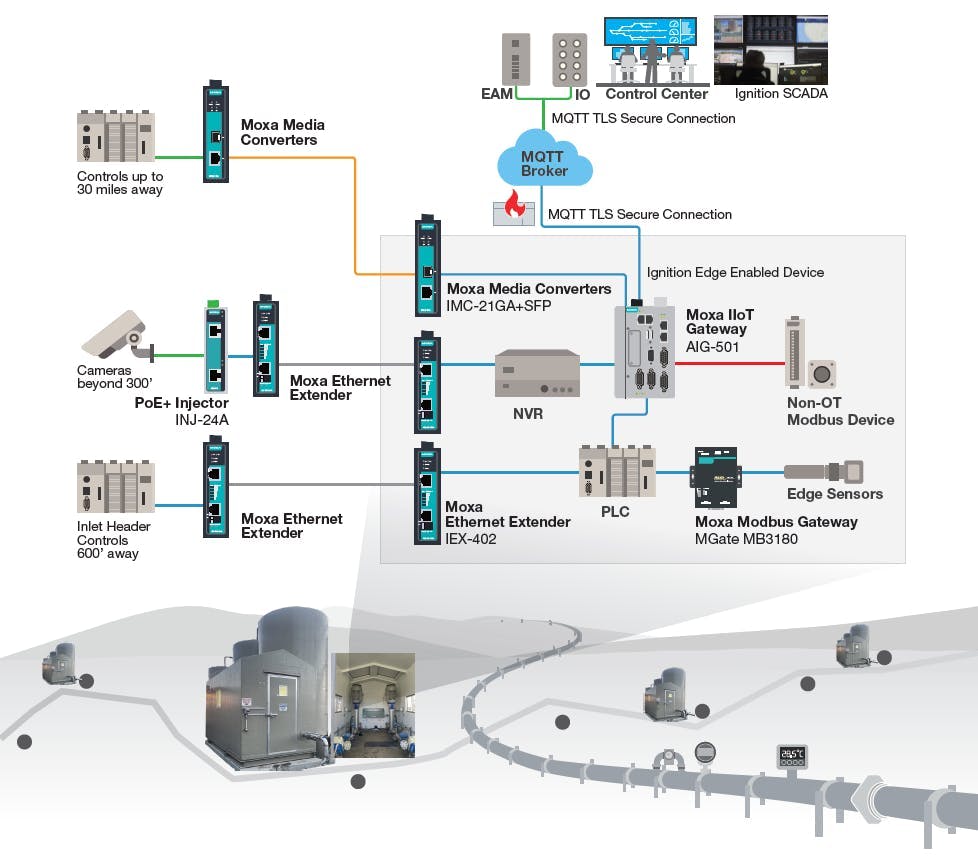Seeking the least-resistant digitalization path
The accelerating reach and impact of digitalization makes it even more crucial for potential users to define the problems they need to solve and specific goals they want to achieve to guide their search for the data processing capabilities, power and locations that will serve them best.
For instance, Dallas-based Goodnight Midstream builds and operates collected-water infrastructures for shale oil and gas producers, and maintains more than 450 miles of gathering and transportation pipelines linked to 50 geologically stable disposal wells for saltwater with chemical and heavy metals from fracking sites across the Williston Basin, Permian Basin and Eagle Ford Shale areas. These pipelines generate huge amounts of data about pipe-wall thickness, leaks, water flowrates, pressure fluctuations, inflow and outflow volumes, and coordinated control of devices, such as valves, pumps and instruments.
Get your subscription to Control's tri-weekly newsletter.
However, gathering and analyzing information from Goodnight Midstream’s pipelines became difficult in recent years as its operations expanded. Its supervisory control and data acquisition (SCADA) system and software relied on multiple virtual private network (VPN) tunnels to securely connect to its central hub and facilities, but managing each VPN connection’s firewall became complex because they required configuration, monitoring and maintenance. This traditional, point-to-point VPN setup also limited the growth of Goodnight Midstream’s infrastructure due to the added resources needed to individually connect and reconfigure every existing site to a new VPN.
“For anyone who’s done large-scale networks, especially distributed out to edges that are way out in the middle of nowhere, VPN tunnels can be the bane of your existence,” says Kevin Cooper, CTO at Goodnight Midstream. “It wasn’t uncommon for us to come into work in the morning, and have seven or eight tickets at the help desk because reports weren't working the way they were supposed to, and we’d inevitably trace them back to a VPN tunnel.”
Replace VPNs with MQTT
To decrease complexity and administrative chores by removing its VPNs, Goodnight Midstream enlisted system integrator CSE Icon to design a gateway architecture, implement a message queuing telemetry transport (MQTT) publish-subscribe broker, and replace its SCADA system during the first eight months of 2023 with web-based, unlimited-license Ignition software from Inductive Automation. Located in the Woodlands, Tex., north of Houston, CSE Icon is a certified member of the Control System Integrators Association (CSIA).
Migrating to MQTT and Ignition was expected to let the pipeline network perform data mining and business intelligence on the system’s backend, deploy Linux at the edge, upgrade easily, use an external database for location information, and improve template support. Goodnight Midstream also wanted MQTT to help it create user-defined types (UDT) and instances for Ignition, migrate data from the former SCADA system, and streamline patch management. To find the right MQTT broker, CSE Icon and Goodnight Midstream also conducted load testing to assess performance under varying demand levels, and settled on Cirrus Link’s Chariot MQTT broker because the results showed it exceeded the project’s requirements by a wide margin.
“Our advice around edge-computing projects is similar to the advice we’d give around any other new or emerging technology—let the requirements drive the solution, and not the other way around,” says Vincent Witzel, president at CSE Icon. “Start with establishing the business problem you’re trying to solve, and identify and vet with a proof of concept (PoC) the technical solutions that could help solve that business problem—and only then implement.”
"Moxa helped us expedite the process, allowing us to set up a new unit in less than 20 minutes, which was a game-changer. It's incredibly helpful when we need to deploy or replace a unit in the field,” explains Rick Hornung, senior IT manager at Goodnight Midstream. “We also chose Moxa’s gateways because they were preloaded with Debian’s Linux-for-the-edge software. Plus, Moxa provides tools to manage those endpoints centrally. We were able to leverage this platform because of Ignition’s portability.”
Likewise, with the previous SCADA network, every tag had to be manually created, so each part of the saltwater pipeline network had its own unique tag list. Using Ignition for SCADA let CSE Icon employ its UDT iterative tag data types to standardize tags from the start. To establish consistent, real-time data exchange between clients and servers, the system integrator developed two types of UDTs, one for pumps and another for tanks. It implemented more than 100,000 tags, each of which included the software’s Open Platform Communications (OPC) item path. However, there were also disabled tags in the UDTs that Goodnight Midstream didn’t want transmitted, which MQTT accommodated because it only transmits data when changes occur to minimize transmissions.
“We expect that MQTT will continue to be implemented, and the traditional Purdue Enterprise Reference Architecture (PERA) will potentially morph into more of a hub-and-spoke model with MQTT broker as the hub,” adds Witzel. “Moreover, value-added capabilities at the MQTT broker will also continue to be enhanced to facilitate things like unified namespaces (UNS).
Simpler saves time
The network upgrade of Goodnight Midstream’s saltwater pipeline was initially planned for 12 months. However, thanks to the project’s database-driven metadata model and close collaboration between CSE Icon and Goodnight Midstream, it was completed in just eight months. The partners report this was an impressive feat, considering it involved replacing the pipeline network’s entire architecture.
“I don't think we pulled one item out of that scope document,” says Goodnight Midstream’s Cooper.
Ignition Edge is now deployed at multiple Goodnight Midstream sites, pulling data directly from PLCs in addition to a polling gateway at the enterprise level for high-speed, cellular-enabled skids that measure pipeline flows. The company no longer needs its former, point-to-point VPNs because all communications are transmitted via MQTT, complete with transport layer security (TLS) setup. Not only is its architecture simpler, but the new SCADA system and network is more secure, reducing overall complexity for IT, and allowing remote acknowledgements among gateways via Twilio.
“Ignition allowed us to move to MQTT, which is optimized for low-bandwidth connections and let us remove all those VPNs,” adds Hornung. “We just pump it out over the networks via its secure protocol, and it dramatically simplifies deployment.”
Cooper reports Ignition also let Goodnight Midstream easily overcome many common concerns for oil and gas processes. “The reservoirs determine where you are, not where you want to be,” he explains, stressing the often extreme, -40 ℉ to 120 ℉ temperatures at its remote sites. “Ignition runs well on Linux devices, and if you pair them, then robust software and hardware lets you deploy low-power, temperature-stable devices in very harsh environments.”
Finally, Ignition’s SCADA system enables Goodnight Midstream to use the same platform across its entire operation, and primes its expected expansion to 30-50 sites in the near future. With the old system, it was necessary to pull up the development environment and add objects to a screen. In contrast, Ignition uses an automatically populated tree view that’s driven by metadata, allowing Goodnight Midstream to enter new data by simply filling in a database table. This task used to take half a day to complete, but now it only takes 15 minutes, which lets Goodnight Midstream’s staff add new sites on their own.
This is part one of Control's February 2025 edge computing cover story. Read all the cover story installments here.



